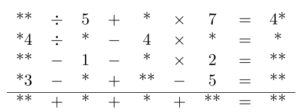Problems
In the dense dark forest ten sources of dead water are erupting from the ground: named from #1 to #10. Of the first nine sources, dead water can be taken by everyone, but the source #10 is in the cave of the dark wizard, from which no one, except for the dark wizard himself, can collect water. The taste and color of dead water is no different from ordinary water, however, if a person drinks from one of the sources, then he will die. Only one thing can save him: if he then drinks poison from a source whose number is greater. For example, if he drinks from the seventh source, then he must necessarily drink poison from the #8, #9 or #10 sources. If he doesn’t drink poison from the seventh source, but does from the ninth, only the poison from the source #10 will save him. And if he originally drinks the tenth poison, then nothing will help him now. Robin Hood summoned the dark wizard to a duel. The terms of the duel were as follows: each brings with him a mug of liquid and gives it to his opponent. The dark wizard was delighted: “Hurray, I will give him poison #10, and Robin Hood can not be saved! And I’ll drink the poison, which Robin Hood brings to me, then ill drink the #10 poison and that will save me!” On the appointed day, both opponents met at the agreed place. They honestly exchanged mugs and drank what was in them. However, afterwards erupted the joy and surprise of the inhabitants of the dark forest, when it turned out that the dark wizard had died, and Robin Hood remained alive! Only the Wise Owl was able to guess how Robin Hood had managed to defeat dark wizard. Try and guess as well.
Prove that the following facts are true for any graph:
a) The sum of degrees of all vertices is equal to twice the number of edges (and therefore it is even);
b) The number of vertices of odd degree is even.
A traveller rents a room in an inn for a week and offers the innkeeper a chain of seven silver links as payment – one link per day, with the condition that they will be payed everyday. The innkeeper agrees, with the condition that the traveller can only cut one of the links. How did the traveller manage to pay the innkeeper?
In the rebus in the diagram below, the arithmetic operations are carried out from left to right (even though the brackets are not written).
For example, in the first row "\(** \div 5 + * \times 7 = 4*\)" is the same as "\(((** \div 5) +*) \times 7 = 4*\)". Each number in the last row is the sum of the numbers in the column above it. The result of each \(n\)-th row is equal to the sum of the first four numbers in the \(n\)-th column. All of the numbers in this rebus are non-zero and do not begin with a zero, however they could end with a zero. That is, 10 is allowed but not 01 or 0. Solve the rebus.

Decode this rebus: replace the asterisks with numbers such that the equalities in each row are true and such that each number in the bottom row is equal to the sum of the numbers in the column above it.
There are 6 locked suitcases and 6 keys for them. It is not known which keys are for which suitcase. What is the smallest number of attempts do you need in order to open all the suitcases? How many attempts would you need if there are 10 suitcases and keys instead of 6?
Three friends – Peter, Ryan and Sarah – are university students, each studying a different subject from one of the following: mathematics, physics or chemistry. If Peter is the mathematician then Sarah isn’t the physicist. If Ryan isn’t the physicist then Peter is the mathematician. If Sarah isn’t the mathematician then Ryan is the chemist. Can you determine which subject each of the friends is studying?
At the cat show, 10 male cats and 19 female cats sit in a row where next to each female cat sits a fatter male cat. Prove that next to each male cat is a female cat, which is thinner than it.
The vendor has a cup weighing scales with unequal shoulders and weights. First he weighs the goods on one cup, then on the other, and takes the average weight. Does he deceive customers?
This problem is from Ancient Rome.
A rich senator died, leaving his wife pregnant. After the senator’s death it was found out that he left a property of 210 talents (an Ancient Roman currency) in his will as follows: “In the case of the birth of a son, give the boy two thirds of my property (i.e. 140 talents) and the other third (i.e. 70 talents) to the mother. In the case of the birth of a daughter, give the girl one third of my property (i.e. 70 talents) and the other two thirds (i.e. 140 talents) to the mother.”
The senator’s widow gave birth to twins: one boy and one girl. This possibility was not foreseen by the late senator. How can the property be divided between three inheritors so that it is as close as possible to the instructions of the will?